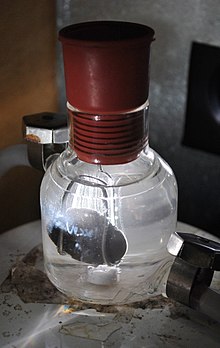
2) disc, exciting electrons within the material. These then react with the water molecules, splitting it into its constituents of hydrogen and oxygen. In this experiment, chemicals dissolved in the water prevent the formation of oxygen, which would otherwise recombine with the hydrogen.
In chemistry, photocatalysis is the acceleration of a photoreaction in the presence of a photocatalyst, the excited state of which "repeatedly interacts with the reaction partners forming reaction intermediates and regenerates itself after each cycle of such interactions."[1] In many cases, the catalyst is a solid that upon irradiation with UV- or visible light generates electron–hole pairs that generate free radicals. Photocatalysts belong to three main groups; heterogeneous, homogeneous, and plasmonic antenna-reactor catalysts.[2] The use of each catalysts depends on the preferred application and required catalysis reaction.
- ^ "Gold Book: Photcatalyst". 2005–2023 International Union of Pure and Applied Chemistry. doi:10.1351/goldbook.PT07446.
- ^ Bertucci, Simone; Lova, Paola (May 2024). "Exploring Solar Energy Solutions for Per- and Polyfluoroalkyl Substances Degradation: Advancements and Future Directions in Photocatalytic Processes". Solar RRL. 8 (9). doi:10.1002/solr.202400116. ISSN 2367-198X.